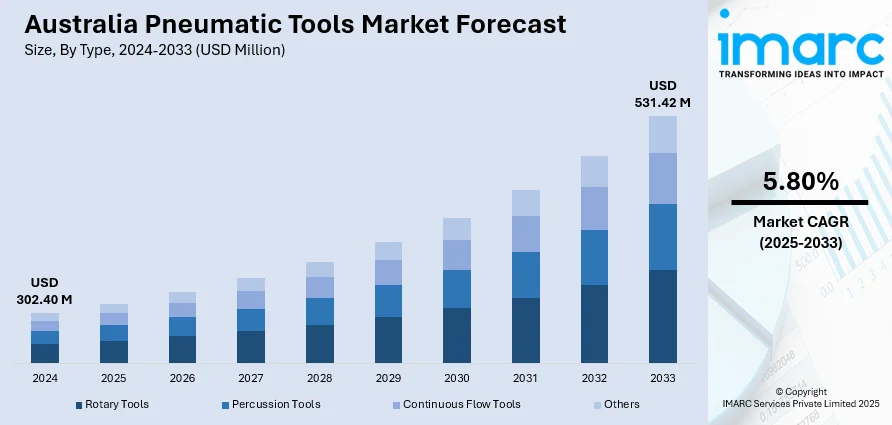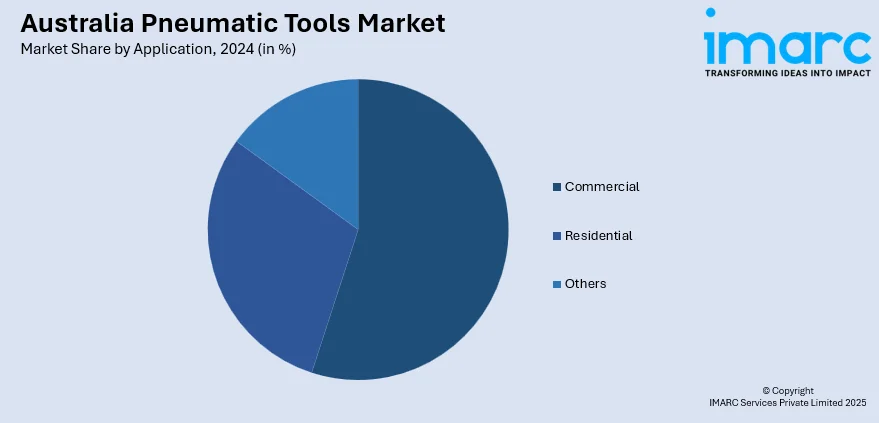
Australia Pneumatic Tools Market Size, Share, Trends and Forecast by Type, Application, End-Use, and Region, 2025-2033
Australia Pneumatic Tools Market Overview:
The Australia pneumatic tools market size reached USD 302.40 Million in 2024. Looking forward, IMARC Group expects the market to reach USD 531.42 Million by 2033, exhibiting a growth rate (CAGR) of 5.80% during 2025-2033. The market is driven by rising energy costs and stringent environmental regulations, pushing industries toward energy-efficient pneumatic tools that reduce operational expenses while supporting sustainability goals. Additionally, the rapid adoption of automation across manufacturing, automotive, and mining sectors fuels demand for high-performance pneumatic systems, valued for their durability and precision in harsh environments. The integration of IoT and smart technologies further enhances efficiency, positioning pneumatics as a critical component in Industry 4.0 advancements, thus augmenting the Australia pneumatic tools market share.
|
Report Attribute
|
Key Statistics
|
|---|---|
|
Base Year
|
2024 |
|
Forecast Years
|
2025-2033
|
|
Historical Years
|
2019-2024
|
| Market Size in 2024 | USD 302.40 Million |
| Market Forecast in 2033 | USD 531.42 Million |
| Market Growth Rate 2025-2033 | 5.80% |
Australia Pneumatic Tools Market Trends:
Increasing Demand for Energy-Efficient Pneumatic Tools
The market is witnessing a growing demand for energy-efficient solutions, driven by accelerating energy costs and stringent environmental regulations. During the fiscal year 2022–23, Australia's net energy use grew 2% to 23,294 PJ, with residential and industrial consumption growing 3% and 4%, respectively. At the same time, renewable sources grew by 12% to 325 PJ or 33% of the nation's electricity supply. Energy use from the transport sector jumped by 19% and agriculture by 12%, while manufacturing fell by 4%. With increasing energy intensity and demand in other sectors, the use of effective industrial pneumatic tools has become more important within the industrial setup of Australia. Industries such as manufacturing, construction, and mining are prioritizing tools that reduce compressed air consumption while maintaining high performance. Manufacturers are responding by introducing advanced pneumatic tools with improved air distribution systems, reduced leakage, and optimized airflow designs. These innovations not only lower operational costs but also align with Australia’s sustainability goals, including carbon emission reduction targets. Additionally, businesses are investing in smart pneumatic systems with sensors and IoT integration to monitor air usage in real time, further enhancing efficiency. As industries continue to focus on cost savings and eco-friendly operations, the adoption of energy-efficient pneumatic tools is expected to accelerate, shaping market growth over the coming years.

To get more information of this market, Request Sample
Growth in Automation and Industrial Applications
Automation and industrial expansion are significantly supporting the Australia pneumatic tools market growth. With industries such as aerospace, automotive, and heavy machinery increasingly adopting automated production lines, the need for reliable, high-performance pneumatic tools has accelerated. Pneumatic systems are preferred for their durability, precision, and ability to operate in harsh environments, making them ideal for automated manufacturing processes. Furthermore, the rise of Industry 4.0 has led to the integration of pneumatics with robotics and IoT-enabled systems, enhancing productivity and reducing downtime. In 2024, more than 35% of businesses in Australia embraced AI and automation. Larger corporations experienced a 60% adoption rate and collectively invested $3.5 Billion in AI technologies. Key economic sectors, including financial services and manufacturing, are utilizing automation for predictive analysis and enhanced process optimization, bolstered by $124 Million in state-funded research and development. This trend indicates a growing demand for smarter, automated machinery within Australia's industrial sector. Australia’s growing infrastructure projects and mining activities are also contributing to demand, as pneumatic tools are essential for drilling, grinding, and material handling. As automation continues to transform industrial operations, the pneumatic tools market is expected to expand, with manufacturers focusing on innovation and customization to meet changing industry needs.
Australia Pneumatic Tools Market Segmentation:
IMARC Group provides an analysis of the key trends in each segment of the market, along with forecasts at the country and regional levels for 2025-2033. Our report has categorized the market based on type, application, and end-use.
Type Insights:
- Rotary Tools
- Percussion Tools
- Continuous Flow Tools
- Others
The report has provided a detailed breakup and analysis of the market based on the type. This includes rotary tools, percussion tools, continuous flow tools, and others.
Application Insights:

- Commercial
- Residential
- Others
A detailed breakup and analysis of the market based on the application have also been provided in the report. This includes commercial, residential, and others.
End-Use Insights:
- Manufacturing Industry
- Automotive Industry
- Construction Industry
- Others
The report has provided a detailed breakup and analysis of the market based on the end-use. This includes manufacturing industry, automotive industry, construction industry, and others.
Regional Insights:
- Australia Capital Territory & New South Wales
- Victoria & Tasmania
- Queensland
- Northern Territory & Southern Australia
- Western Australia
The report has also provided a comprehensive analysis of all the major regional markets, which include Australia Capital Territory & New South Wales, Victoria & Tasmania, Queensland, Northern Territory & Southern Australia, and Western Australia.
Competitive Landscape:
The market research report has also provided a comprehensive analysis of the competitive landscape. Competitive analysis such as market structure, key player positioning, top winning strategies, competitive dashboard, and company evaluation quadrant has been covered in the report. Also, detailed profiles of all major companies have been provided.
Australia Pneumatic Tools Market News:
- October 10, 2024: Norbar Torque Tools Ltd. launched the EvoTorque Battery Tool Compact (EBT-C), a battery-powered, compact torque tool featuring patented transducer control and intelligent joint sensing technology to ensure high accuracy and repeatability. Designed for pneumatic tools in bolting applications, the EBT-C offers enhanced performance, making it ideal for various Australian industries, including manufacturing and construction. Building on 80 years of expertise, Norbar's EBT-C caters to businesses that require accuracy and efficiency in their pneumatic tool usage.
Australia Pneumatic Tools Market Report Coverage:
| Report Features | Details |
|---|---|
| Base Year of the Analysis | 2024 |
| Historical Period | 2019-2024 |
| Forecast Period | 2025-2033 |
| Units | Million USD |
| Scope of the Report |
Exploration of Historical Trends and Market Outlook, Industry Catalysts and Challenges, Segment-Wise Historical and Future Market Assessment:
|
| Types Covered | Rotary Tools, Percussion Tools, Continuous Flow Tools, Others |
| Applications Covered | Commercial, Residential, Others |
| End-Uses Covered | Manufacturing Industry, Automotive Industry, Construction Industry, Others |
| Regions Covered | Australia Capital Territory & New South Wales, Victoria & Tasmania, Queensland, Northern Territory & Southern Australia, Western Australia |
| Customization Scope | 10% Free Customization |
| Post-Sale Analyst Support | 10-12 Weeks |
| Delivery Format | PDF and Excel through Email (We can also provide the editable version of the report in PPT/Word format on special request) |
Key Questions Answered in This Report:
- How has the Australia pneumatic tools market performed so far and how will it perform in the coming years?
- What is the breakup of the Australia pneumatic tools market on the basis of type?
- What is the breakup of the Australia pneumatic tools market on the basis of application?
- What is the breakup of the Australia pneumatic tools market on the basis of end-use?
- What is the breakup of the Australia pneumatic tools market on the basis of region?
- What are the various stages in the value chain of the Australia pneumatic tools market?
- What are the key driving factors and challenges in the Australia pneumatic tools market?
- What is the structure of the Australia pneumatic tools market and who are the key players?
- What is the degree of competition in the Australia pneumatic tools market?
Key Benefits for Stakeholders:
- IMARC’s industry report offers a comprehensive quantitative analysis of various market segments, historical and current market trends, market forecasts, and dynamics of the Australia pneumatic tools market from 2019-2033.
- The research report provides the latest information on the market drivers, challenges, and opportunities in the Australia pneumatic tools market.
- Porter's five forces analysis assist stakeholders in assessing the impact of new entrants, competitive rivalry, supplier power, buyer power, and the threat of substitution. It helps stakeholders to analyze the level of competition within the Australia pneumatic tools industry and its attractiveness.
- Competitive landscape allows stakeholders to understand their competitive environment and provides an insight into the current positions of key players in the market.
Need more help?
- Speak to our experienced analysts for insights on the current market scenarios.
- Include additional segments and countries to customize the report as per your requirement.
- Gain an unparalleled competitive advantage in your domain by understanding how to utilize the report and positively impacting your operations and revenue.
- For further assistance, please connect with our analysts.
 Request Customization
Request Customization
 Speak to an Analyst
Speak to an Analyst
 Request Brochure
Request Brochure
 Inquire Before Buying
Inquire Before Buying




.webp)




.webp)












